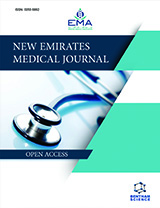Abstract
Background: Allergic rhinitis (AR) is a common chronic health problem in the United Arab Emirates (UAE). Achieving adequate symptom control is pivotal to successful AR management, which may be attained following a stepwise treatment algorithm. Despite the availability of several guideline recommendations for the best management of AR, morbidity remains high in patients with AR, with treatment goals being far from reach.
Objective: The objective of this consensus statement was to discuss the currently available knowledge on the treatment of AR and to provide an expert opinion on the use of MP-AzeFlu (azelastine HCl, AZE; 137 μg per spray) and INCS (fluticasone propionate, FP; 50 μg per spray) for the effective management of AR in the UAE.
Methods: A consensus meet involving 13 otorhinolaryngologists and one pulmonologist was held in Dubai, UAE, to discuss the current understanding of the treatment and management of AR.
Results: The panel advised to start AR pharmacotherapy with antihistamines (AH), leukotriene receptor antagonist (LTRA), INCS or MP-AzeFlu based on the visual analogue scale (VAS) score. In mild intermittent AR (VAS score <5/10), AH or LTRA is recommended as first-line therapy. However, in case of VAS score ≥5/10 or persistent AR, and treatment failure with AHs alone, INCS or MP-AzeFlu is recommended, followed by reassessment for 7 days to confirm a step-up or step-down therapy. Patients non-responsive to therapy were advised to step-up with MP-AzeFlu.
Conclusion: The panel advocated a combination of intranasal second-generation AH and INCS in a single device (Dymista®) as first-line therapy for the management of AR. The algorithm provided herein can be applied in most healthcare settings by following a step-up or step-down strategy based on the VAS scores for AR control in the UAE.
Keywords: allergic rhinitis, azelastine HCl, dymista, fluticasone propionate, treatment algorithm, United Arab Emirates
[http://dx.doi.org/10.1097/ACI.0b013e32832b4651] [PMID: 19390434]
[http://dx.doi.org/10.1111/j.1398-9995.2007.01620.x] [PMID: 18331513]
[http://dx.doi.org/10.1016/S0091-6749(97)80043-7]
[http://dx.doi.org/10.1016/j.otohns.2007.02.031] [PMID: 17512862]
[http://dx.doi.org/10.1185/03007995.2011.559580] [PMID: 21401446]
[http://dx.doi.org/10.2500/ajra.2012.26.3836] [PMID: 23232281]
[http://dx.doi.org/10.1016/j.jaci.2019.06.049] [PMID: 31627910]
[http://dx.doi.org/10.1016/j.jaci.2017.03.050] [PMID: 28602936]
[http://dx.doi.org/10.1111/j.1398-9995.2009.02123.x] [PMID: 19735489]
[http://dx.doi.org/10.1159/000129607] [PMID: 18523395]
[http://dx.doi.org/10.1002/ppul.20331] [PMID: 16283628]
[http://dx.doi.org/10.1371/journal.pone.0217182] [PMID: 31242201]
[http://dx.doi.org/10.2500/aap.2007.28.2991] [PMID: 18307838]
[http://dx.doi.org/10.2165/00151829-200504060-00007] [PMID: 16336028]
[http://dx.doi.org/10.1164/ajrccm.162.4.9912033] [PMID: 11029350]
[http://dx.doi.org/10.2500/aap.2009.30.3230] [PMID: 19549425]
[http://dx.doi.org/10.1111/j.1399-3038.2009.00933.x]
[http://dx.doi.org/10.1185/030079907X178793] [PMID: 17407638]
[http://dx.doi.org/10.1586/eci.09.38] [PMID: 20477689]
[http://dx.doi.org/10.1186/1710-1492-9-16] [PMID: 23635091]
[http://dx.doi.org/10.1016/j.amjmed.2003.10.030] [PMID: 14984820]
[http://dx.doi.org/10.2739/kurumemedj.58.9] [PMID: 22027192]
[http://dx.doi.org/10.1002/alr.21185] [PMID: 23733270]
[http://dx.doi.org/10.2147/JAA.S98172] [PMID: 27468241]
[http://dx.doi.org/10.1111/j.1365-2125.2012.04222.x] [PMID: 22356350]
[http://dx.doi.org/10.1016/j.jaci.2012.01.077] [PMID: 22418065]
[http://dx.doi.org/10.1016/j.jaip.2018.01.031] [PMID: 29425904]
[http://dx.doi.org/10.1016/j.jaip.2016.02.006] [PMID: 27084419]
[http://dx.doi.org/10.2500/aap.2012.33.3587] [PMID: 22856633]
[http://dx.doi.org/10.2500/aap.2015.36.3823] [PMID: 25562555]
[http://dx.doi.org/10.2500/aap.2016.37.3979] [PMID: 27657521]
[http://dx.doi.org/10.1002/iid3.237] [PMID: 30306729]
[http://dx.doi.org/10.1111/j.1398-9995.2007.01307.x] [PMID: 17298337]
[http://dx.doi.org/10.21037/jtd.2017.11.91] [PMID: 29268538]
[http://dx.doi.org/10.21037/jtd.2018.12.84] [PMID: 30746253]
[http://dx.doi.org/10.1111/all.13125] [PMID: 28072463]
[http://dx.doi.org/10.1016/j.jaci.2019.01.053] [PMID: 30951790]
[http://dx.doi.org/10.1016/j.anai.2009.11.063] [PMID: 20306814]
[http://dx.doi.org/10.1111/j.1365-2222.2011.03734.x] [PMID: 21518040]
[http://dx.doi.org/10.1111/cea.12121] [PMID: 23889242]
[http://dx.doi.org/10.3109/02770903.2013.786726] [PMID: 23506422]
[http://dx.doi.org/10.1016/j.jaci.2010.06.034] [PMID: 20816198]
[http://dx.doi.org/10.1080/14712598.2020.1729350] [PMID: 32053391]
[http://dx.doi.org/10.1186/2045-7022-5-S4-P40]
[http://dx.doi.org/10.1186/s13223-018-0311-4] [PMID: 30574167]
[http://dx.doi.org/10.1038/s41533-016-0001-y] [PMID: 28115736]
[http://dx.doi.org/10.5414/ALX02120E] [PMID: 32176226]
[http://dx.doi.org/10.7326/M17-2203] [PMID: 29181536]
[http://dx.doi.org/10.1111/j.1365-2222.2007.02888.x] [PMID: 18081563]
[http://dx.doi.org/10.2500/ajr.2007.21.3058] [PMID: 17882923]
[http://dx.doi.org/10.1016/j.otohns.2007.08.005] [PMID: 18036421]
[http://dx.doi.org/10.2500/aap.2011.32.3444] [PMID: 21477425]
[http://dx.doi.org/10.1185/030079906X80305] [PMID: 16393441]
[http://dx.doi.org/10.1111/cea.12556] [PMID: 25900517]
[http://dx.doi.org/10.1185/03007990802155792] [PMID: 18498678]



























